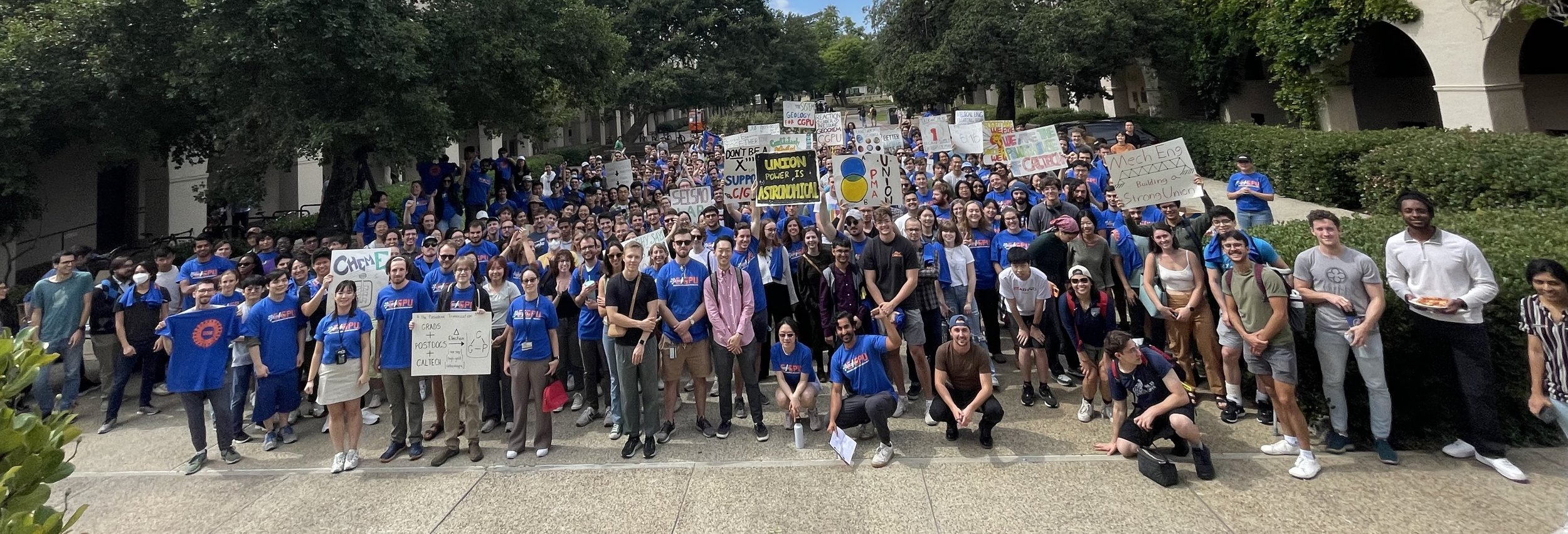Reflecting on the Caltech Grad & Postdoc Election Wins
Beating The Anti-Union Campaign With A Strong Network Of Worker Leaders
By Aditi Narayanan, C/GPU
Caltech graduate students and postdoctoral scholars are officially unionized! A historic 72% of graduate students and 52% of postdocs came out to vote on January 31st and February 1st, with 76% and 83% voting yes respectively (not including challenge ballots). This is the first time in academic labor history that grads and postdocs have unionized at the same time. Caltech is somewhat unique in having significantly more grads and postdocs than undergraduate students, and unionization was driven more by the insufficient worker protections for research rather than teaching roles.
Our unionization campaign was not without its hurdles. Caltech prides itself on its lack of bureaucracy (while this allows a degree of flexibility in the workplace, it also makes it nearly impossible to access basic administrative functions). The administration’s anti-union campaign leaned heavily on the idea that a union would destroy the flexibility that makes Caltech special. Caltech also hired the well-known anti-labor law firm Proskauer Rose LLP to develop their anti-union messaging, which included misleading statements about the union’s effect on researcher/advisor relationships and an attempt to cast the unionization effort as a fringe movement led by an outside force. The administration carefully constructed a façade of neutrality, highlighting their Proskauer-Rose-approved anti-unionization website as a place from which to get the “complete” picture of unionization’s effects. This “complete” picture was usually pushed to students and postdocs by their own advisors; Caltech leveraged the power imbalance between researchers and faculty to turn entire labs against unionization. If negativity and false neutrality were the stick, conveniently timed wage increases and open office hours with the dean were the uninspired carrot. But workers who want bread and roses will not accept wilting root vegetables.
Graduate students and postdocs share many of the same material problems with their working conditions, and campaigning together allowed us to spread resources more evenly, capitalize on each other’s momentum, and build a stronger community. We credit our success to a tireless group of nearly a hundred organizers who had thousands of face-to-face conversations with their peers. The power of one-to-one organizing in this campaign cannot be overstated; by developing department- and building-specific networks and regularly walking through workspaces to talk to people, almost every voter had a familiar face to whom they could direct questions.
These networks needed to be built from the ground-up by people who knew the territory; Caltech has six academic divisions, and we set up a committee for each one to identify areas that needed more coverage, plan divisional events, and schedule walkthroughs. These committees, as well as our central organizing committee, met weekly and were open to any student or postdoc. Our central committee meetings were around fifteen to twenty organizers strong, while divisional meetings were usually between three to seven people. Postdocs also had a separate committee to ensure that their needs would be met on a student-dominated campus. Our goal was to either recruit one organizer per research group or identify an organizer who could take responsibility for more hesitant groups in their building. These “area leaders” were responsible for keeping their colleagues informed and mobilizing them for town halls, rallies, and the election; many also became regular attendees at organizing meetings. We made a point of reaching out personally to enthusiastic people we met on walkthroughs to encourage them to get involved.
Ultimately, we brought on over 110 new organizers over the course of the campaign who covered about 90% of campus buildings. New organizers met with a more experienced peer to familiarize themselves with the campaign before jumping in. People of all experience levels were welcome and had the freedom to set the hours per week they could commit to the campaign. We believe that making organizing accessible to everyone created a strong community that could not only weather an extraordinary amount of anti-union rhetoric but do so while achieving historic voter turnout.
Despite the administration’s best attempts, Caltech grads and postdocs are ready to bargain for higher wages, better healthcare, childcare assistance, protections against abuse and harassment, and financial support for international scholars. We gratefully acknowledge the UC and USC locals for their contemporaneous strike and contract campaigns, which were perfect examples of the change that collective action could bring. CGPU-UAW represents over 2000 people who want to do their jobs without worrying about rent or putting food on the table. Currently, we are expanding our organizing structure, surveying our peers to solidify bargaining priorities, and electing bargaining teams. We are excited to join the larger UAW family and proud to be a part of the resurgent labor movement in the United States.

